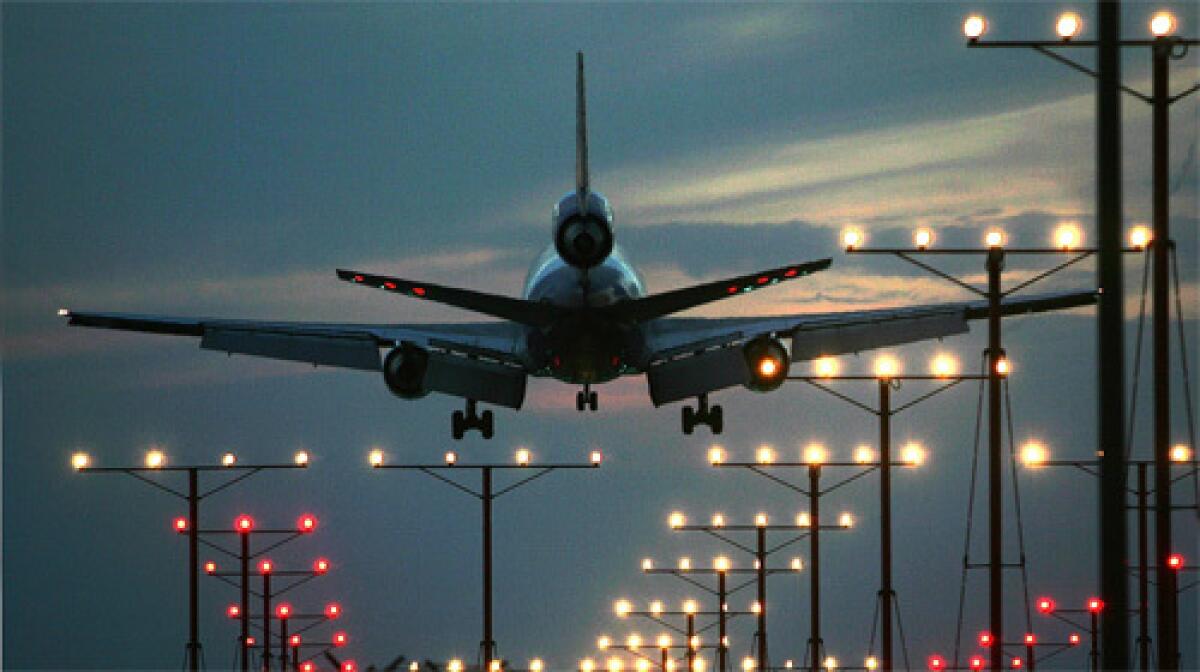Air traffic controllers’ labor tactics raise concern

It’s “unsafe” at busy airports throughout the country. There’s a “staffing emergency” in air traffic control facilities serving Southern California. A “dangerous situation” in the skies and on the ground is about to “get worse.”
National Air Traffic Controllers Assn. President Patrick Forrey made those allegations last week in news releases and during a teleconference with reporters in the latest salvo in a long-standing labor dispute between the union and the Federal Aviation Administration.
The disagreement over how to best staff air traffic facilities that guide planes through increasingly congested airspace and around busy airports has gotten personal.
Union leaders and the FAA agree that the nation’s aviation system faces great challenges, including replacing most of its controller workforce in the next decade and modernizing the antiquated air traffic control system. Even so, transportation experts and FAA officials took strong exception to Forrey’s comments, citing accident rates that are at historic lows.
“I have zero hesitation putting myself or my family on any airplane at any airport in this country, and the flying public should feel the same,” said Hank Krakowski, the chief operating officer of the FAA’s air traffic control organization.
But the union is standing by its statements. Veteran controllers say they see themselves as “guardians of public safety,” who must warn travelers that there are too few controllers to safely handle more flights. Most of the nation’s controllers -- many of whom are replacement workers hired after President Reagan fired striking traffic controllers in 1981 -- are set to retire in the next few years.
“Our strategy is speak from the facts, to speak from the heart,” said Hamid Ghaffari, the union’s Western Pacific regional vice president and a controller at the Los Angeles Air Route Traffic Control Center in Palmdale, which handles high-altitude flights.
“We’re really trying to avoid a situation where, obviously, we create any kind of panic among the public,” he said. “At the same time, it would be absolutely irresponsible for us to pretend that there’s nothing wrong.”
The intensifying rhetoric concerns safety advocates, who say controllers have crossed the line by trying to scare passengers as a way to solve a contractual dispute.
“I think that anyone that is in a safety position has a responsibility to not obviously use inflammatory language and maintain their comments on a factual basis,” said Jim Hall, a former chairman of the National Transportation Safety Board, who now runs a transportation consulting business.
Although many labor disputes, such as in the auto or film industries, periodically turn nasty, most don’t so clearly affect the well-being of people who use the product. For beleaguered passengers already coping with fears of terrorism, security restrictions and flight delays, the labor dispute is just one more thing to worry about.
“I’m concerned because I’m flying almost every other week,” said Kate Hanni, the Napa, Calif.-based founder of the Coalition for the Airline Passenger Bill of Rights. “Planes clearly are not falling out of the sky, but there are some problems that appear to be creeping up that could become critical.”
One of those problems, controllers say, is that fatigue resulting from increased overtime is leading to more close calls between aircraft on the ground and in the air.
The FAA disagrees.”We don’t see any statistical rise in fatigue or staffing-related events at all,” Krakowski said.
The controllers’ argument was bolstered recently by a federal report that found runway safety gains achieved earlier this decade have been eroded in part by tired controllers making mistakes. The report led the Los Angeles City Council to unanimously pass a largely symbolic resolution calling on the FAA to hire more controllers at LAX, which the union says is short-staffed. The agency disagrees.
Controllers and the FAA have been in a heated labor dispute since 2006, when the FAA declared an impasse in contract negotiations and imposed new work rules covering union members, including new staffing requirements, cuts in pay for new hires and a dress code.
The union has used a number of strategies to try to persuade the FAA to reopen talks, including asking male members to wear dresses to work, filing repeated grievances with managers and releasing dozens of news releases filled with incendiary language.
The FAA says it is on track to hire thousands of controllers by 2016 but acknowledges controllers are retiring at a higher rate than they have in the past. To stem the tide, the agency is discussing offering incentives to keep seasoned workers on the job, Krakowski said.
As the dispute wears on, it would behoove aviation unions, who for decades played the safety card to try to further contract talks, to tone down the rhetoric, safety experts say.
“In my experience, I’ve seen excessive use of language by all the parties in the system,” said Hall, the transportation consultant. “I’ve never seen that that has really been a contributor to solving the problems.”
More to Read
Sign up for Essential California
The most important California stories and recommendations in your inbox every morning.
You may occasionally receive promotional content from the Los Angeles Times.










